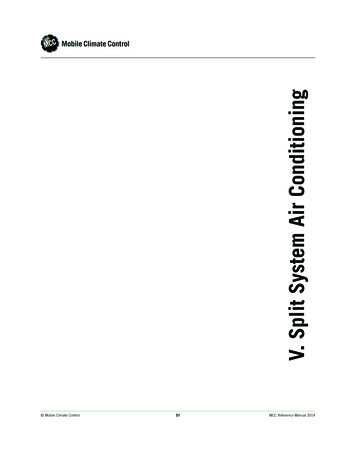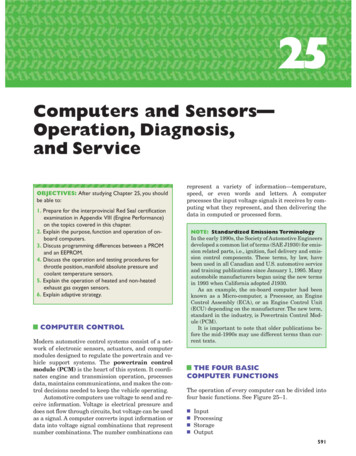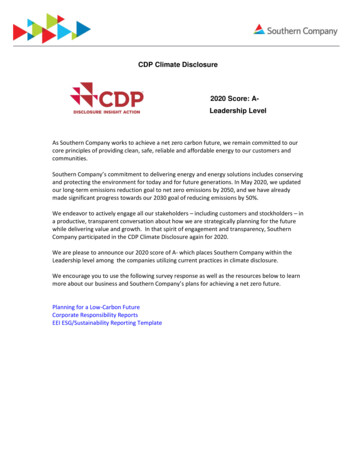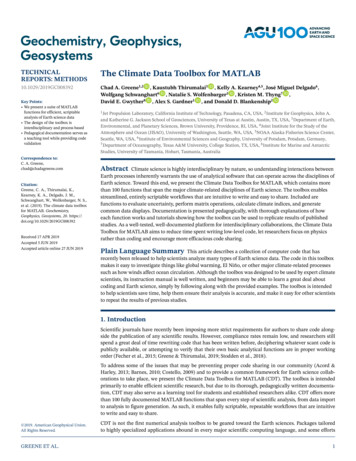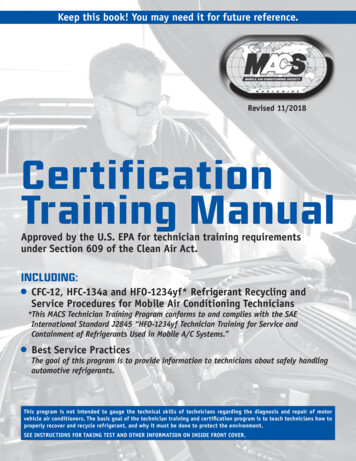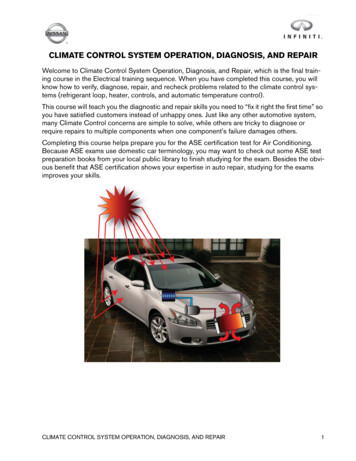
Transcription
CLIMATE CONTROL SYSTEM OPERATION, DIAGNOSIS, AND REPAIRWelcome to Climate Control System Operation, Diagnosis, and Repair, which is the final training course in the Electrical training sequence. When you have completed this course, you willknow how to verify, diagnose, repair, and recheck problems related to the climate control systems (refrigerant loop, heater, controls, and automatic temperature control).This course will teach you the diagnostic and repair skills you need to “fix it right the first time” soyou have satisfied customers instead of unhappy ones. Just like any other automotive system,many Climate Control concerns are simple to solve, while others are tricky to diagnose orrequire repairs to multiple components when one component's failure damages others.Completing this course helps prepare you for the ASE certification test for Air Conditioning.Because ASE exams use domestic car terminology, you may want to check out some ASE testpreparation books from your local public library to finish studying for the exam. Besides the obvious benefit that ASE certification shows your expertise in auto repair, studying for the examsimproves your skills.CLIMATE CONTROL SYSTEM OPERATION, DIAGNOSIS, AND REPAIR1
WHAT IS CLIMATE CONTROL?Climate Control refers to the systems in a vehicle that allow customers to adjust air temperature,humidity, and direction of discharged air. Although we usually think of climate control as just acomfort feature, the defroster is a safety feature. Air conditioning also improves the air quality,which may benefit people with certain health problems, by dehumidifying and cleaning the air asits cooled passing over the evaporator fins.All the components of the Climate Control system work together as a complete system. Understanding the relationship between these components will help you accurately verify and diagnose complaints. For example, when a customer selects Defrost, the system opens the fresh airintake door, activates the heater core and refrigerant loop, directs air over the evaporator and theheater core, and blows this warm, dry air through the defroster ducts on the dashboard. If anyone of these components isn't working properly, the customer will have concerns about poordefroster performance. Similarly, a customer may have concerns with poor air conditioner performance if the Sunload sensor has failed and the ATC is no longer accounting for the heatingcaused by sunlight on the vehicle.2WHAT IS CLIMATE CONTROL?
SYSTEM OVERVIEWAll Nissan and Infiniti vehicles, except the first and second generation Nissan Quests, have thesame basic refrigerant loop components, and all models except the Frontier, Xterra, Versa,Cube, and Sentra are available with ATC. Once you've learned how the basic systems work, youcan apply this knowledge to any vehicle.The five major components of the refrigerant loop are: Evaporator Compressor Condenser Liquid tank (receiver/drier) Expansion valveCondenserCompressorCooled LiquidRefrigerantto Liquid k typeexpansion valveNOTE:LiquidtankThe receiver/drier is referred to as the “liquid tank” in electronic service manuals.WHAT IS CLIMATE CONTROL?3
The basic operation of the refrigerant loop is quite simple: it moves heat from the interior of thevehicle to the outside air. The compressor compresses the refrigerant and directs it through the system. The condenser transfers heat to the outside air and condenses the refrigerant to a liquid. The receiver drier (liquid tank) filters the refrigerant and stores any excess liquid. The thermal expansion valve (TXV) sprays a mist of refrigerant into the evaporator to start theloop again. The evaporator absorbs heat from inside the passenger compartment and incoming air whenthe intake is set to FRESH.All these components are connected by rigid metal tubes and flexible hoses, and are sealed withvarious seals and O-rings.A variation of this basic system layout is found in the first and second generation Nissan Quest,which has a fixed orifice tube (FOT) and an accumulator in the basic system and a thermalexpansion valve (TXV) in the optional rear air conditioner.The engine compartment is a harsh environment due to vibration and heat, so it's no surprise themost common A/C problem is low refrigerant charge due to gradual leakage.System Diagram - Refrigerant Loop ComponentsPressure relief Outside airCondenserLiquid tankBlower motorEvaporatorExpansion valve4WHAT IS CLIMATE CONTROL?
Review Questions1. Climate Control allows customers to do which function: (Check all that apply) Allow customers to adjust air temperature, control humidity, and the direction of discharged air Allow customers to set the in-vehicle temperature to a comfortable setting Create an environment warmer, colder, or more comfortable than the ambient (outsideair) All of the above2.The compressor performs which of the following functions: The compressor transfers heat to the outside airThe compressor filters and stores the refrigerantThe compressor compresses the refrigerant and directs it through the systemAbsorbs heat from the passenger compartmentSafetyAutomotive air conditioners operate under high pressures and use refrigerants that can be dangerous if improperly handled. Service and repairs should be performed only by properly trainedpersons who understand refrigeration systems and their operation. They must have access tospecialized service tools and equipment while following approved safety precautions. Additionally, any HVAC system refrigerant recovery repairs require special licensing. Always wear eye protection when working on the refrigerant loop. If refrigerant contacts youreye it may freeze and cause permanent injury. Refrigerant can quickly cause frostbite. Avoid skin contact with refrigerant. Always weargloves when working with refrigerant. Work in a well ventilated area. Since refrigerant evaporates quickly, breathing may becomedifficult due to lack of oxygen in poorly ventilated areas. Keep refrigerant away from open flame. Poisonous gas is produced when R-12 refrigerantburns. Never heat liquid refrigerant above 104 F. as this may cause the container to explode. Neverapply direct flame to a refrigerant container. Keep refrigerant containers stored below 104 F. Never release refrigerant directly into the atmosphere. It's a federal law with fines and imprisonment for anyone releasing refrigerant into the atmosphere. Always use approved recovery,recycling, and charging equipment.WHAT IS CLIMATE CONTROL?5
Never mix R-134a and R-12 or their refrigerant oils. Results will range from poor A/C systemperformance to expensive component and equipment damage. There are many different Federal, state, and local ordinances controlling the use of refrigerants and their release into the atmosphere. Make sure you comply with these ordinances,including training and certification.RefrigerantOperationThe refrigerant in an air conditioning system absorbs, transports, and then releases heat via thecondenser. A good refrigerant must have a number of specific characteristics. It must be: Compatible with a wide variety of materials such as brass, aluminum, copper, steel, rubberand neoprene. Oil soluble, which allows it to circulate through the system with the oil. Non-poisonous and non-flammable.Unfortunately, no single substance found in nature has all these characteristics. Automotiverefrigerants are man-made compounds developed especially for automotive air conditioning systems.Automotive refrigerant has changed over the years from ammonia gas, to R12 (Freon), toR134a. The characteristics of each gas and the purpose in the refrigerant system have remainedthe same. The primary automotive refrigerant in general use today is R134a. Although the name“Freon” is sometimes used to refer to any automotive refrigerant, “Freon” is a registered trademark of DuPont.R134a refrigerant is more environmentally friendly than R-12. Systems using R134a haveslightly higher pressures than an R12 system. In addition, R134a systems use a different type ofrefrigerant oil which is specific to the type of compressor. R134a systems use a lower charge ofrefrigerant compared to R12 systems.There is a distinct temperature-pressure relationship for R-134a refrigerant. As the pressureincreases, the boiling point rises. Refer to the chart on the following page for these relationships.6WHAT IS CLIMATE CONTROL?
R134a Temperature - Pressure ComparisonTemp VAP0RATORRANGEPressurepsigTemp 2CONDENSERRANGEReview Question1. Refrigerant should be compatible with which of the following materials: (Check all thatapply) Brass, aluminum, copper, steel, rubber, neoprene Titanium, magnesium, copper, steel, rubber, neoprene Steel, neoprene, synthetic oil, cosmoline Brass, magnesium, copper, galvanized steelWHAT IS CLIMATE CONTROL?7
MalfunctionsAll automotive A/C systems eventually require service. A typical A/C system needs rechargingevery three or four years, and contamination in the system (water, incorrect oil, dirt, metal fragments, acids) can cause a wide variety of problems. Much contamination can be prevented bykeeping things clean while working on the HVAC system. Make sure all valves and fittings arefree of grease and dirt, and keep the protective caps on components, lines, and hoses untilready for installation. Always flush the system using equipment made for flushing AC systemsafter failure of the compressor, receiver/drier, or accumulator, as these components can introduce debris into the system when they fail. Always verify you are using the right type of oil for thecompressor.DiagnosisCooling performance will be inadequate if the refrigerant is undercharged. To rule out othercauses of poor cooling performance, perform touch and feel diagnosis. If the refrigerant chargeis low, the thermal expansion valve and receiver/drier (or the fixed orifice tube) will be warm orslightly cool to the touch. Both high-pressure and low-pressure readings are low if refrigerantundercharge is the cause. Always check for leaks and make any required repairs before recharging the AC system. As a rule of thumb, never increase the amount of R134a refrigerant chargedinto the AC system. R134a systems operate more efficiently than R12 systems and require lessrefrigerant.The compressor may benoisy if the refrigerant isovercharged. If the A/Calternates between working well and not working,an excessive refrigerantcharge may be causingicing. If both high-pressureand low-pressure readingsare high, and particularly ifsplashing water on thecondenser lowers thepressure, you will need toremove enough refrigerantto meet the specification inthe service manual.Pressure relief liquidHigh-pressureliquidLow-pressuregasOutside airLiquid r motorEvaporatorCOOLWARMCOLDExpansion valve8WHAT IS CLIMATE CONTROL?
A better understanding of basic principles of refrigeration,makes diagnosing A/C problems easier. Refrigeration worksby taking advantage of a few simple physical principles:1.Heat travels from high temperature to low temperatureareas.2.Compressing a gas or vapor increases both its temperature and pressure.3.Removing heat from a gas or vapor makes it condenseinto a liquid.4.Raising the temperature of a liquid makes it evaporateinto a gas or vapor.TEMPERATUREINCREASESAT RESTCOMPRESSIONGASGASWhen refrigerant enters the evaporator as a mist, it vaporizes and absorbs heat from the passenger compartment andfresh intake air until the refrigerant leaves the evaporator as aslightly superheated vapor.The vaporized refrigerant travels through the low-pressurevapor lines to the compressor. The pistons in the compressor pressurize the refrigerant raising its temperature.This hot, high-pressure refrigerant vapor goes through thehigh-pressure vapor lines to the condenser at the front of thecar. Because the refrigerant is much hotter than the outside air, air passing through the condenser absorbs heat from the refrigerant. As the refrigerant loses heat, it condenses to a liquid.WHAT IS CLIMATE CONTROL?9
Next, the warm liquid refrigerant passes through the liquid line to the receiver/drier (liquid tank)to absorb any moisture or impurities which could damage the system.System Diagram - Refrigerant Loop ComponentsPressure relief Outside airCondenserLiquid tankBlower motorEvaporatorExpansion valveThe refrigerant is still a warm liquid as it continues through the liquid line to the thermal expansion valve (TXV). When the refrigerant leaves the thermal expansion valve (TXV), the liquidrefrigerant vaporizes. During normal system operation, the TXV allows enough liquid refrigerantinto the evaporator to keep it partially filled with vaporizing liquid refrigerant while the systemoperates.Review Questions1. R134a systems require charging a greater amount of refrigerant into the system comparedto R12 systems: (Check one) True False2.Identify which of the following statements are correct: (Check all that apply) 10Heat travels from high temperature to low temperature areas.Compressing a gas or vapor increases both its temperature and pressure.Removing heat from a gas or vapor makes it condense into a liquid.Raising the temperature of a liquid makes it evaporate into a gas or vapor.All of the aboveWHAT IS CLIMATE CONTROL?
Refrigerant Loop ComponentsThe refrigerant loop consists of a grou
Completing this course helps prepare you for the ASE certification test for Air Conditioning. Because ASE exams use domestic car terminology, you may want to check out some ASE test preparation books from your local public library to finish studying for the exam. Besides the obvi-ous benefit that ASE certification shows your expertise in auto repair, studying for the exams improves your skills .
